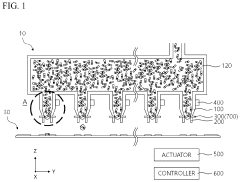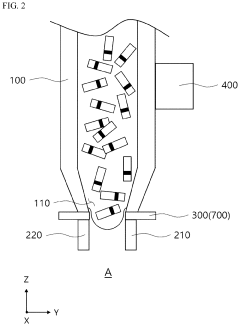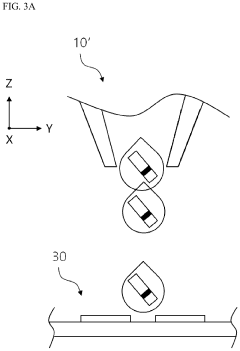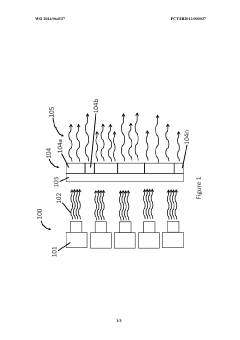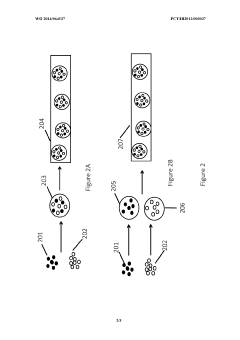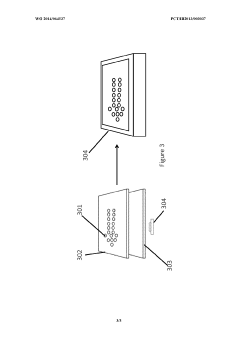QNED Technology: Transforming Digital Signage Displays
QNED Tech Evolution
QNED (Quantum Nano Emitting Diode) technology has undergone a remarkable evolution since its inception, revolutionizing the digital signage display industry. This innovative display technology combines the strengths of quantum dot and mini-LED technologies to create a superior visual experience.
The journey of QNED began with the development of quantum dot technology in the early 2000s. Quantum dots, nanoscale semiconductor particles, were initially used to enhance color reproduction in LCD displays. As research progressed, scientists discovered ways to integrate quantum dots with LED backlighting, leading to the emergence of QLED (Quantum dot LED) displays.
Concurrently, mini-LED technology was advancing, offering improved local dimming capabilities and higher contrast ratios compared to traditional LED-backlit displays. The convergence of these two technologies gave birth to QNED, which combines the color accuracy of quantum dots with the precise light control of mini-LEDs.
The first commercial QNED displays were introduced in the market around 2021, marking a significant milestone in display technology. These early models demonstrated superior brightness, contrast, and color accuracy compared to conventional LCD and OLED displays, particularly in large-format applications such as digital signage.
As QNED technology matured, manufacturers focused on improving production efficiency and reducing costs. This led to the development of more advanced quantum dot materials and more precise mini-LED placement techniques. By 2023, QNED displays had become increasingly prevalent in high-end digital signage installations, offering unparalleled image quality and energy efficiency.
The most recent advancements in QNED technology have centered on enhancing pixel density and reducing power consumption. Researchers have been working on developing smaller quantum dots and more efficient mini-LEDs, allowing for higher resolution displays without sacrificing brightness or color accuracy. Additionally, efforts have been made to improve the longevity of QNED displays, addressing concerns about potential degradation of quantum dot materials over time.
Looking ahead, the QNED technology roadmap includes several exciting developments. One area of focus is the integration of QNED with flexible display technologies, potentially enabling large-format curved or rollable digital signage solutions. Another promising direction is the exploration of micro-LED integration with quantum dots, which could lead to even more precise light control and higher pixel densities.
As QNED technology continues to evolve, it is poised to play an increasingly important role in the digital signage industry. Its ability to deliver exceptional image quality, energy efficiency, and durability makes it an attractive option for a wide range of applications, from retail environments to outdoor advertising displays. The ongoing research and development in this field suggest that QNED technology will continue to push the boundaries of what is possible in digital display technology for years to come.
Digital Signage Demand
The digital signage market has experienced significant growth in recent years, driven by the increasing demand for dynamic and interactive display solutions across various industries. As businesses and organizations seek more effective ways to engage with their audiences, digital signage has emerged as a powerful tool for communication, advertising, and information dissemination.
The global digital signage market size was valued at USD 21.49 billion in 2020 and is projected to reach USD 32.84 billion by 2025, growing at a CAGR of 7.5% during the forecast period. This growth is attributed to several factors, including the declining costs of display technologies, advancements in hardware and software capabilities, and the increasing adoption of digital signage in retail, transportation, healthcare, and corporate sectors.
In the retail industry, digital signage has become an essential component of the customer experience, enabling retailers to showcase products, promote sales, and provide real-time information to shoppers. The transportation sector has also embraced digital signage for wayfinding, schedule updates, and passenger information systems in airports, train stations, and bus terminals.
The healthcare industry has seen a surge in digital signage adoption for patient education, wayfinding, and communication in hospitals and clinics. Corporate environments are utilizing digital displays for internal communications, meeting room scheduling, and visitor management systems.
The demand for digital signage is further fueled by the growing trend of smart cities and the integration of Internet of Things (IoT) technologies. As urban areas become more connected, digital displays play a crucial role in providing real-time information, enhancing public safety, and improving the overall urban experience.
The COVID-19 pandemic has also accelerated the adoption of digital signage solutions, particularly in sectors such as healthcare and retail, where contactless communication and information dissemination have become essential. Digital displays are being used to convey safety guidelines, occupancy limits, and other critical information to the public.
As the market continues to evolve, there is an increasing demand for higher resolution displays, improved energy efficiency, and more advanced content management systems. This has led to the development of new technologies like QNED (Quantum Nano Emitting Diode), which promises to deliver superior image quality and performance compared to traditional LCD and LED displays.
The growing emphasis on sustainability and energy efficiency is also shaping the demand for digital signage solutions. Businesses and organizations are seeking displays that consume less power and have a reduced environmental impact, driving innovation in display technologies and power management systems.
QNED Challenges
Despite the promising potential of QNED technology in transforming digital signage displays, several significant challenges need to be addressed for its widespread adoption and commercial success.
One of the primary challenges is the complexity of manufacturing QNED panels at scale. The process involves precise alignment and integration of multiple components, including quantum dots, nanorod LEDs, and color filters. Achieving consistent quality and yield rates in mass production remains a significant hurdle, potentially impacting the cost-effectiveness of QNED displays.
Color accuracy and stability present another critical challenge. While QNED technology promises superior color performance, maintaining consistent color output over time and across different operating conditions is crucial. Factors such as temperature variations and long-term usage may affect the quantum dot and nanorod LED performance, potentially leading to color shifts or degradation.
Power efficiency is an area that requires further improvement. Although QNED displays are more energy-efficient than traditional LCD panels, there is still room for optimization to compete with OLED technology, especially in terms of power consumption for large-format displays and outdoor signage applications.
Longevity and durability of QNED displays pose additional challenges, particularly for digital signage applications that often require 24/7 operation in various environmental conditions. Ensuring the long-term stability of quantum dots and nanorod LEDs under continuous use and exposure to different temperatures and humidity levels is crucial for the technology's success in the signage market.
The cost of QNED displays is currently higher than conventional LCD and LED technologies, which may limit initial adoption in price-sensitive markets. Reducing production costs through improved manufacturing processes and economies of scale is essential for QNED to gain a competitive edge in the digital signage industry.
Another challenge lies in the integration of QNED displays with existing digital signage infrastructure and content management systems. Ensuring compatibility with current hardware and software solutions while leveraging the unique capabilities of QNED technology requires careful consideration and potential adaptations in the signage ecosystem.
Lastly, educating the market about the benefits and capabilities of QNED technology presents a significant challenge. Many potential customers and end-users may be unfamiliar with QNED, necessitating comprehensive marketing and educational efforts to demonstrate its advantages over existing display technologies in digital signage applications.
QNED Implementation
01 QNED display technology overview
QNED (Quantum Nano Emitting Diode) technology combines quantum dot and mini-LED backlighting to enhance display quality. This technology offers improved color accuracy, contrast ratios, and brightness levels compared to traditional LCD displays. QNED displays provide a wider color gamut and better HDR performance, resulting in more vibrant and lifelike images.- QNED display technology overview: QNED (Quantum Nano Emitting Diode) technology combines quantum dot and NanoCell technologies to enhance display quality. It uses mini-LED backlighting to provide improved contrast, brightness, and color accuracy compared to traditional LED displays. This technology offers a wider color gamut and better HDR performance, resulting in more vibrant and lifelike images.
- Color enhancement and accuracy: QNED displays utilize quantum dot technology to enhance color reproduction and accuracy. The quantum dots emit precise wavelengths of light, resulting in more saturated and pure colors. This technology allows for a wider color gamut, enabling the display to reproduce a larger range of colors with greater accuracy and vibrancy.
- Contrast and black level improvements: The mini-LED backlighting used in QNED displays allows for more precise local dimming, resulting in improved contrast ratios and deeper black levels. This technology enables better control over individual zones of the display, enhancing the overall picture quality and providing a more immersive viewing experience, especially in dark scenes.
- Image processing and enhancement: QNED displays incorporate advanced image processing algorithms to optimize picture quality. These algorithms can enhance details, reduce noise, and improve motion handling. The technology also includes features such as HDR processing and upscaling to further enhance the overall visual experience and display quality.
- Energy efficiency and display longevity: QNED technology aims to improve energy efficiency while maintaining high display quality. The use of mini-LEDs and quantum dots allows for better light management and reduced power consumption compared to traditional LED displays. Additionally, the technology is designed to provide longer display lifespan and improved resistance to image retention or burn-in issues.
02 Color enhancement and accuracy
QNED technology utilizes quantum dots to enhance color reproduction and accuracy. The quantum dots emit precise wavelengths of light, resulting in more saturated and accurate colors. This technology allows for a wider color gamut, enabling the display to reproduce a larger range of colors with greater precision and vibrancy.Expand Specific Solutions03 Contrast and black level improvements
The mini-LED backlighting in QNED displays enables local dimming, which significantly improves contrast ratios and black levels. By precisely controlling the brightness of individual LED zones, QNED technology can achieve deeper blacks and brighter highlights, resulting in enhanced image quality and more realistic HDR content reproduction.Expand Specific Solutions04 Brightness and energy efficiency
QNED displays offer improved brightness levels while maintaining energy efficiency. The combination of quantum dots and mini-LED backlighting allows for higher peak brightness without significantly increasing power consumption. This results in more vivid and impactful visuals, particularly in HDR content, while still being energy-efficient.Expand Specific Solutions05 Image processing and enhancement algorithms
QNED technology incorporates advanced image processing algorithms to further improve display quality. These algorithms optimize color mapping, contrast enhancement, and motion handling, resulting in smoother motion, reduced artifacts, and overall improved picture quality. The processing techniques work in conjunction with the hardware improvements to deliver a superior viewing experience.Expand Specific Solutions
Display Industry Players
QNED technology is emerging as a transformative force in the digital signage display market, currently in its early growth stage. The market size is expanding rapidly, driven by increasing demand for high-quality, energy-efficient displays. While the technology is still evolving, major players like LG Electronics, Samsung Electronics, and BOE Technology Group are investing heavily in research and development. These companies are at various stages of technological maturity, with LG Electronics leading the commercialization efforts. Other significant contributors include Sharp, NEC, and Intel, each bringing unique expertise to advance QNED technology. As the technology matures, we can expect increased competition and innovation from both established display manufacturers and new entrants in the field.
LG Electronics, Inc.
BOE Technology Group Co., Ltd.
QNED Core Innovations
- An inkjet head with nozzles and pairs of electrodes that apply an electrode voltage to the light-emitting elements, including a first and second piezoelectric element, and a controller to independently control the electrode voltage, allowing for precise arrangement of light-emitting elements on a substrate with separate electrodes before and during the jetting process.
- The use of a fully soluble quantum dot (QD) ink to form a remote phosphor layer for signage, which provides color tuneability across the visible spectrum using heavy metal-free QD phosphorescent materials, integrated with a solid-state LED backlight for efficient and safe illumination.
Energy Efficiency
Energy efficiency is a critical aspect of QNED (Quantum Nano Emitting Diode) technology, particularly in its application to digital signage displays. QNED displays offer significant improvements in energy consumption compared to traditional LCD and LED technologies, making them an attractive option for businesses looking to reduce their environmental impact and operational costs.
QNED technology utilizes quantum dots and nanorod LEDs to produce highly efficient light emission. This combination results in displays that require less power to achieve the same brightness levels as conventional displays. The precise control over individual pixels allows for more efficient use of energy, as only the necessary pixels are illuminated at any given time.
One of the key factors contributing to QNED's energy efficiency is its ability to produce deep blacks. Unlike traditional LCD displays that require constant backlighting, QNED can completely turn off individual pixels, resulting in true blacks and significantly reduced power consumption in darker scenes. This feature is particularly beneficial for digital signage applications that often display content with varying brightness levels.
The high luminance efficiency of QNED technology also plays a crucial role in its energy-saving capabilities. QNED displays can achieve higher brightness levels with lower power input compared to conventional display technologies. This efficiency translates to reduced energy consumption, especially in high-brightness environments such as outdoor digital signage installations.
Furthermore, QNED technology demonstrates excellent thermal management properties. The efficient light emission process generates less heat compared to traditional display technologies, reducing the need for energy-intensive cooling systems. This not only contributes to overall energy savings but also extends the lifespan of the display, further enhancing its sustainability credentials.
In the context of digital signage, where displays often operate for extended periods, the energy efficiency of QNED technology can lead to substantial cost savings over time. Businesses can benefit from reduced electricity bills while simultaneously lowering their carbon footprint. This aligns well with growing corporate sustainability initiatives and regulatory requirements for energy-efficient technologies.
As QNED technology continues to evolve, further improvements in energy efficiency are expected. Ongoing research focuses on enhancing the quantum efficiency of the nano-emitters and optimizing the overall display architecture to minimize power losses. These advancements promise to push the boundaries of energy efficiency in digital signage displays, making QNED an increasingly attractive option for businesses seeking to balance visual performance with environmental responsibility.
Content Optimization
Content optimization plays a crucial role in maximizing the impact of QNED (Quantum Nano Emitting Diode) technology in digital signage displays. As this innovative display technology offers superior image quality and performance, it is essential to tailor content to fully leverage its capabilities.
QNED displays boast exceptional color accuracy, contrast ratios, and brightness levels. To optimize content for these displays, designers and content creators must focus on utilizing the full color gamut available. This involves creating vibrant, high-contrast visuals that take advantage of the deep blacks and bright whites that QNED technology can produce. Additionally, the use of HDR (High Dynamic Range) content becomes particularly effective, as QNED displays can accurately reproduce a wide range of luminance levels.
The high refresh rates and fast response times of QNED displays also open up new possibilities for dynamic content. Motion graphics, animations, and video content can be displayed with exceptional smoothness and clarity. Content creators should consider incorporating more fluid animations and transitions to showcase the display's capabilities and enhance viewer engagement.
Resolution optimization is another critical aspect of content creation for QNED displays. As these displays often feature high pixel densities, content should be designed at appropriate resolutions to maintain sharpness and detail. This may involve creating content at 4K or even 8K resolutions, depending on the specific display specifications.
The improved viewing angles of QNED technology also influence content optimization strategies. Unlike some other display technologies, QNED maintains color accuracy and brightness even at wide viewing angles. This characteristic allows for more flexibility in content placement and layout, as information can remain legible from various perspectives.
To fully exploit the capabilities of QNED displays, content creators should also consider the ambient lighting conditions in which the displays will be used. QNED technology performs well in both bright and dark environments, so content can be optimized for various lighting scenarios. This might involve creating different versions of content for day and night viewing or implementing adaptive brightness features.
Lastly, the energy efficiency of QNED displays should be taken into account when optimizing content. While these displays are generally more efficient than traditional LCD or LED displays, thoughtful content design can further reduce power consumption. This can be achieved by using darker backgrounds when appropriate and minimizing the use of full-screen bright elements for extended periods.
